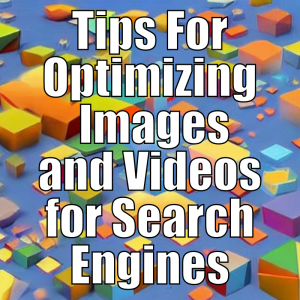 Optimizing website images and videos for search engines is crucial to improve your website’s visibility, attract more traffic, and ultimately generate more leads and revenue. When it comes to online content, images and videos are just as important as written content. Therefore, it’s important to ensure that they are optimized properly to get the most out of them.
Optimizing website images and videos for search engines is crucial to improve your website’s visibility, attract more traffic, and ultimately generate more leads and revenue. When it comes to online content, images and videos are just as important as written content. Therefore, it’s important to ensure that they are optimized properly to get the most out of them.
Here are some tips for optimizing website images and videos for search engines:
1: Use relevant and descriptive file names
When saving an image or video file, use a descriptive name that accurately reflects the content of the file. For example, if you’re uploading an image of a red dress, name the file “red-dress.jpg” instead of using a generic name like “IMG1234.jpg”. This makes it easier for search engines to understand the content of the file and include it in search results.
2: Use alt text for images and transcripts for videos
Alt text is a short description of an image that is used by search engines to understand its content. Make sure to include alt text for all images on your website and use relevant keywords in the text. Similarly, for videos, include transcripts that contain the text of the audio. This makes it easier for search engines to index your content and display it in search results.
3: Compress images for faster loading times
Large image files can slow down your website’s loading times, which can negatively impact your search engine rankings. To prevent this, compress your image files before uploading them to your website. There are several online tools and plugins that can help you compress your images without compromising their quality.
4: Use image and video sitemaps
An image sitemap is a file that provides search engines with information about the images on your website, including their location and metadata. Similarly, a video sitemap provides information about the videos on your website. By creating and submitting these sitemaps to search engines, you can help them understand and index your visual content.
5. Use relevant and high-quality images and videos
Using relevant and high-quality images and videos can improve the user experience of your website and encourage visitors to stay longer. This can have a positive impact on your search engine rankings, as search engines take user engagement into account when determining rankings. Make sure to use images and videos that are relevant to your content and of a high quality.
6: Use video hosting platforms
If you’re hosting videos on your website, it’s important to use a video hosting platform instead of hosting the videos directly on your website. Video hosting platforms like YouTube and Vimeo have built-in optimization features that can improve the visibility of your videos in search results. They also have the ability to automatically generate transcripts and captions for your videos, which can improve their accessibility and search engine rankings.
7: Use structured data for videos
Structured data is a type of code that provides search engines with more detailed information about the content of your website. For videos, you can use structured data to provide information such as the title, description, duration, and thumbnail image. This can help search engines understand the content of your videos and display them more prominently in search results.
Conclusion: Are Image and Video Optimization Really That Important?
In conclusion, optimizing website images and videos for search engines is crucial for improving your website’s visibility, attracting more traffic, and ultimately generating more leads and revenue. By following the tips outlined in this article, you can ensure that your visual content is properly optimized and effectively contributes to your website’s SEO efforts.
If any of these tactics or techniques seem to be too much for you, or you just don’t have time to do it yourself, why not reach out and let the team at Purpose Driven Promotion help!
Let’s Work Together
TELL US MORE ABOUT YOUR PROJECT
Let us help you get your website found. Or, if you simply have a few questions, then fill out the form below and we will get back to you.

